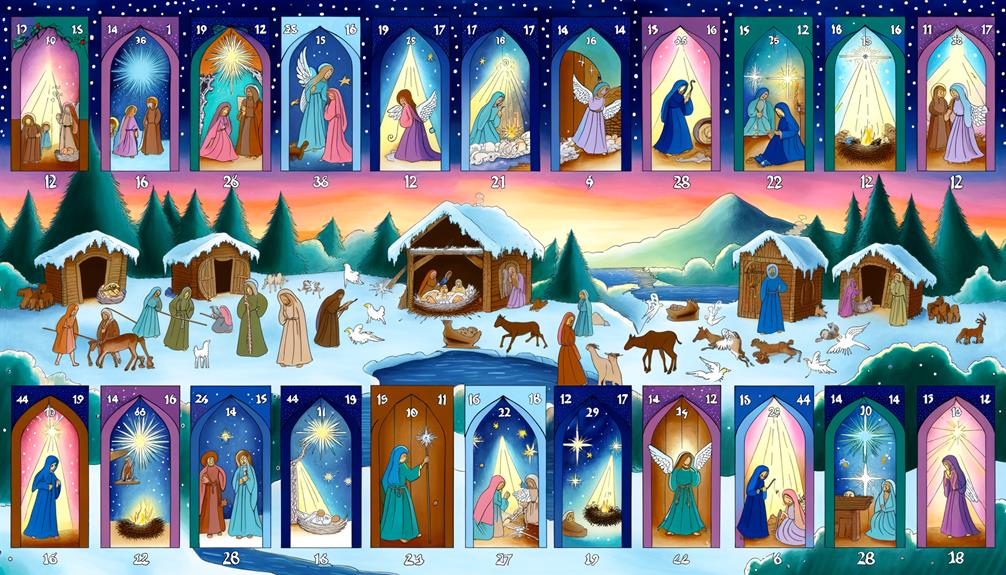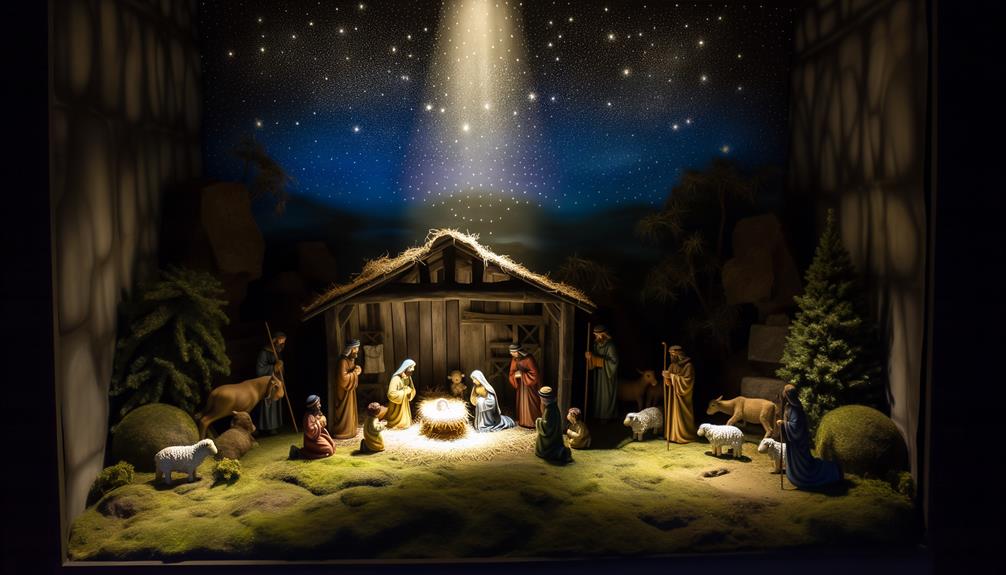Advent Calendar Meaning of Each Day in the Bible: Explain!
An Advent calendar, rich in biblical significance, marks each day with themes from scripture that collectively highlight the anticipation and fulfillment of the Messiah’s coming. Beginning with Old Covenant prophecies such as Isaiah 9:6-7 and Micah 5:2, these days meditate on the foretold divine authority and eternal reign of Jesus.
Events like the Annunciation (Luke 1:35-38), Joseph and Mary’s journey to Bethlehem (Luke 2:1-5), the shepherds’ vision (Luke 2:8-14), and the Nativity story interweave theology and historical narrative, signifying hope and redemption. Continue to explore how each day builds on these profound theological truths.

Key Takeaways
- Each day of Advent reflects themes of prophecy, annunciation, journey, and nativity events, aligning with scriptural narratives.
- Advent days focus on anticipation and preparation for the Messiah’s birth, emphasizing fulfillment of Old Covenant prophecies.
- The Annunciation and Mary’s faith are highlighted, showcasing divine intervention and obedience in the Advent narrative.
- The journey to Bethlehem symbolizes faith and divine providence, reflecting messianic prophecy fulfillment.
Advent Calendar Meaning of Each Day in the Bible: Spiritual Reflection and Preparation for Christ
| Week/Day | Biblical Theme |
|---|---|
| Week 1: Hope (Prophecy) | Focuses on the prophecies of Christ’s coming, emphasizing hope and God’s promises (Isaiah 9:6-7) |
| Week 2: Peace | Reflects on the peace that Jesus brings to the world, fulfilling the prophecies (Isaiah 53:5) |
| Week 3: Joy (Shepherds’ Joy) | Celebrates the joy of the shepherds who received the news of Christ’s birth (Luke 2:10) |
| Week 4: Love | Focuses on the love of God demonstrated through the birth of Jesus (John 3:16) |
| Christmas Eve | Symbolizes the arrival of Christ, the light of the world, and the fulfillment of God’s plan (John 1:14) |
| Daily Reflections | Each day is a reminder of Christ’s light, preparing hearts through scripture, prayer, and reflection |
Prophecies of the Messiah

Foretold through various prophetic texts in the Old Covenant, the coming of the Messiah is a central theme that underscores the anticipation and hope reflected in the traditions of the Advent calendar.
Scriptures such as Isaiah 9:6-7 and Micah 5:2 provide vivid portrayals of the promised Savior. Isaiah speaks of a child born to us, a son given, with titles like ‘Wonderful Counselor’ and ‘Prince of Peace,’ signifying divine authority and eternal reign.
Micah, meanwhile, foretells the birthplace of the Messiah in Bethlehem, emphasizing the ancient origins and the shepherding role of this future leader.
These prophecies shape the Advent season’s reflective nature, inviting the faithful to meditate upon the fulfillment of these divine promises.
The Annunciation

In the Gospel of Luke, the Annunciation marks a pivotal moment, where the angel Gabriel reveals to Mary that she will conceive and bear a son, Jesus, who will be called the Son of the Most High. This profound announcement signifies the fulfillment of Old Covenant prophecies and underscores Mary’s unique role within the divine plan.
Gabriel’s declaration, “The Holy Spirit will come upon you,” (Luke 1:35) emphasizes the miraculous nature of Christ’s conception. This event underscores the divine intervention and supernatural presence in the birth of Jesus. It also serves as a foreshadowing of the significance of Pentecost day when the Holy Spirit would descend upon the disciples, empowering them to spread the gospel. The parallel between Christ’s conception and the events of Pentecost highlights the overarching theme of God’s miraculous and redemptive work throughout human history.
Mary’s response, “Behold, I am the servant of the Lord; let it be to me according to your word,” (Luke 1:38) exemplifies her faith and obedience.
The Annunciation therefore serves as a cornerstone event in Christian theology, heralding the incarnation of the Savior.
Journey to Bethlehem

The Journey to Bethlehem, as recounted in the Gospels, underscores the fulfillment of Messianic prophecies and the humble circumstances surrounding Jesus’ birth.
According to Luke 2:1-5, Joseph and Mary traveled to Bethlehem to comply with the Roman decree for a census. This journey not only aligns with Micah 5:2, which foretells the Messiah’s birth in Bethlehem, but also emphasizes the ordinariness of Jesus’ origins.
The arduous trek symbolizes obedience and faith amid adversity, as Mary, despite her advanced pregnancy, undertakes a difficult journey.
This narrative invites reflection on divine providence and the intersection of human obedience with God’s redemptive plan, illustrating how humble beginnings can herald profound spiritual transformation.
The Shepherds’ Vision

Amid the stillness of the night, the shepherds’ vision of angelic hosts heralding the birth of Christ serves as a profound witness to the divine revelation bestowed upon the humble and the lowly.
Luke 2:8-14 meticulously recounts this extraordinary event, where angels proclaimed, ‘Glory to God in the highest, and on earth peace, good will toward men.’
This moment underscores the theological theme that God’s message of salvation is accessible to all, irrespective of social status.
The shepherds, representing ordinary people, exemplify the recipients of divine grace and the bearers of good news.
Their experience symbolizes God’s inclusive love, breaking societal barriers and inviting humanity to partake in the joy of Christ’s arrival.
The Nativity Story

Rooted in the Gospel narratives of Matthew and Luke, the Nativity Story meticulously details the humble circumstances surrounding the birth of Jesus Christ, emphasizing theological themes of divine incarnation and fulfillment of prophetic scripture.
The accounts highlight Joseph and Mary’s journey to Bethlehem, the manger’s simplicity, and the angelic announcements, all underscoring God’s intervention in human history. This narrative not only fulfills Old Covenant prophecies but also introduces Jesus as the Messiah, whose birth signifies hope and redemption for humanity.
| Element | Description |
|---|---|
| Prophecy | Fulfillment of Old Covenant promises |
| Incarnation | God becoming human in Jesus Christ |
| Setting | Bethlehem, a humble manger |
| Angelic Message | Announcements to shepherds and wise men |
| Theological Theme | Hope, redemption, divine intervention |
Conclusion
The Advent calendar serves as a symbolic tapestry, intricately woven with threads of prophecy, annunciation, journey, vision, and nativity.
Each day unfolds a scriptural revelation, guiding believers through the sacred narrative of the Messiah’s arrival. As they reflect on the teachings and prophecies woven throughout the texts, they discover insights that illuminate their faith and understanding. The 8th day significance in scripture serves as a profound reminder of new beginnings and the fulfillment of God’s promises. This day, often associated with covenant renewal and spiritual rebirth, encourages believers to embrace their own transformations and the hope that comes with the Messiah’s presence among them.
The prophecies lay the foundation, the annunciation heralds hope, the journey signifies faith, the shepherds’ vision illuminates divine truth, and the nativity manifests the culmination of divine promise.
Together, these elements encapsulate the essence of Advent, a period of profound spiritual reflection and anticipation.






